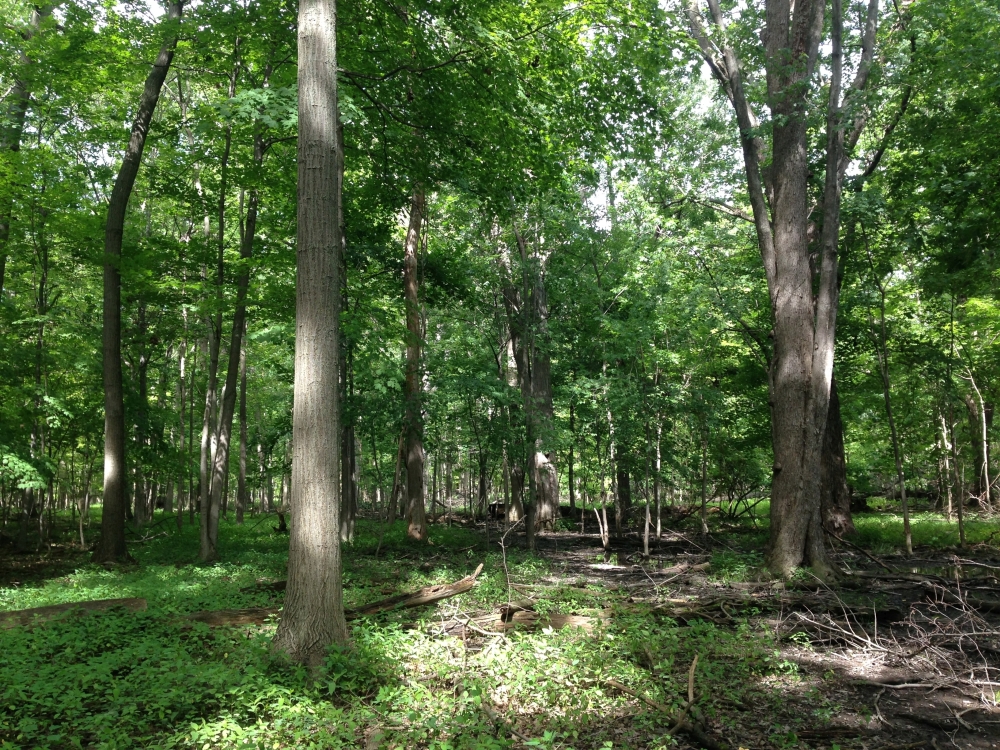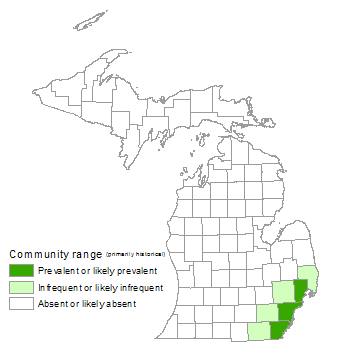Wet-mesic Flatwoods
Overview
Wet-mesic flatwoods is a wet to mesic forest on mineral soils dominated by a highly diverse mixture of upland and lowland hardwoods. The community occurs almost exclusively on poorly drained glacial lakeplain in southeastern Lower Michigan. Dominant trees may include oaks, hickories, maples, ashes, and basswood. Seasonal inundation is the primary natural disturbance factor influencing wet-mesic flatwoods.
Rank
Global Rank: G2G3 - Rank is uncertain, ranging from imperiled to vulnerable
State Rank: S2 - Imperiled

Landscape Context
Wet-mesic flatwoods occurs on low relief, poorly drained glacial lakeplain characterized by the presence of an impervious clay layer, or, locally, where similar conditions exist outside the glacial lakeplain.
Soils
Surface soils are typically medium to slightly acid sandy loam to loam and overlay mildly to moderately alkaline sandy clay loam, clay loam, or clay. An underlying impermeable clay lens is often present, which allows for prolonged pooling of water. Seasonal water level fluctuations lead to mottling of the mineral soil layers.
Natural Processes
Seasonal inundation due to low relief and the presence of an impervious clay layer leads to the development of a patchy, sparse ground layer. Water levels are typically highest in the late winter and spring, creating many vernal pools. Strong water level fluctuations over the growing season favor species otherwise typical of river and stream floodplains. Seasonally dry mineral soils allow for greater tree-rooting depth than in wetlands on organic soils, reducing the prevalence of windthrow. The role of fire in wet-mesic forests on the lakeplain is not well understood. Historically, where wet-mesic flatwoods bordered lakeplain prairies and lakeplain oak openings, surface fire likely spread through portions of the community when standing water was absent.
Vegetation
Wet-mesic flatwoods is characterized by a highly diverse tree canopy that reflects variations in soil moisture as a response to slight changes in surface topography and mineral soil composition across most sites. Canopy tree species may include both mesic and wetland species. Dominant trees are red oak (Quercus rubra), Shumard’s oak (Q. shumardii, state special concern), white oak (Q. alba), swamp white oak (Q. bicolor), chinquapin oak (Q. muhlenbergii), pin oak (Q. palustris), bur oak (Q. macrocarpa), shagbark hickory (Carya ovata), bitternut hickory (C. cordiformis), shellbark hickory (C. laciniosa), American beech (Fagus grandifolia), sugar maple (Acer saccharum), black maple (A. nigrum), silver maple (A. saccharinum), red maple (A. rubrum), green ash (Fraxinus pennsylvanica), white ash (F. americana), pumpkin ash (F. profunda, state threatened), and basswood (Tilia americana). Very slight rises in topography are interspersed with lower, wet stands of swamp white oak, pin oak, red maple, silver maple, and green ash. In addition, tree species associated with floodplain forests may also be present, including cottonwood (Populus deltoides), sycamore (Platanus occidentalis), and hackberry (Celtis occidentalis). The state-listed tree species Shumard’s oak and pumpkin ash may be dominant in some sites but absent from others. American elm (Ulmus americana) is an important understory component in most stands and likely was once an overstory dominant prior to the introduction of Dutch elm disease. Other common species in the understory include saplings of canopy tree species (especially red and silver maple), musclewood (Carpinus caroliniana), ironwood (Ostrya virginiana), prickly ash (Zanthoxylum americanum), maple-leaved arrow-wood (Viburnum acerifolium), and spicebush (Lindera benzoin). The ground layer may be locally sparse due to frequent inundation. Species typical of both mesic forests and wetlands are present, including poison ivy (Toxicodendron radicans), enchanter’s nightshade (Circaea canadensis), jumpseed (Persicaria virginiana), clearweed (Pilea pumila), jack-in-the-pulpit (Arisaema triphyllum), may apple (Podophyllum peltatum), Gray’s sedge (Carex grayi), great bladder sedge (C. intumescens), blue-stemmed goldenrod (Solidago caesia), broad-leaved goldenrod (S. flexicaulis), riverbank grape (Vitis riparia), and wild geranium (Geranium maculatum).
For information about plant species, visit the Michigan Flora website.
Plant Lists
Graminoids
- sedges (Carex grayi, C. intumescens, C. lupulina, C. muskingumensis, C. tuckermanii, and others)
- fowl manna grass (Glyceria striata)
Forbs
- jack-in-the-pulpit (Arisaema triphyllum)
- spotted water hemlock (Cicuta maculata)
- enchanter’s-nightshade (Circaea canadensis)
- wild geranium (Geranium maculatum)
- southern blue flag (Iris virginica)
- common water horehound (Lycopus americanus)
- northern bugle weed (Lycopus uniflorus)
- jumpseed (Persicaria virginiana)
- clearweed (Pilea pumila)
- may apple (Podophyllum peltatum)
- bluestem goldenrod (Solidago caesia)
- broad-leaved goldenrod (Solidago flexicaulis)
Ferns
- wood ferns (Dryopteris spp.)
- sensitive fern (Onoclea sensibilis)
- royal fern (Osmunda regalis)
- New York fern (Thelypteris noveboracensis)
Woody Vines
- Virginia creeper (Parthenocissus quinquefolia)
- poison-ivy (Toxicodendron radicans)
- riverbank grape (Vitis riparia)
Shrubs
- rough-leaved dogwood (Cornus drummondii)
- witch-hazel (Hamamelis virginiana)
- winterberry (Ilex verticillata)
- spicebush (Lindera benzoin)
- maple-leaved arrow-wood (Viburnum acerifolium)
- prickly ash (Zanthoxylum americanum)
Trees
- black maple (Acer nigrum)
- red maple (Acer rubrum)
- silver maple (Acer saccharinum)
- sugar maple (Acer saccharum)
- musclewood (Carpinus caroliniana)
- bitternut hickory (Carya cordiformis)
- shellbark hickory (Carya laciniosa)
- shagbark hickory (Carya ovata)
- hackberry (Celtis occidentalis)
- hawthorns (Crataegus spp.)
- American beech (Fagus grandifolia)
- white ash (Fraxinus americana)
- green ash (Fraxinus pennsylvanica)
- pumpkin ash (Fraxinus profunda)
- ironwood (Ostrya virginiana)
- sycamore (Platanus occidentalis)
- cottonwood (Populus deltoides)
- white oak (Quercus alba)
- swamp white oak (Quercus bicolor)
- bur oak (Quercus macrocarpa)
- chinquapin oak (Quercus muehlenbergii)
- pin oak (Quercus palustris)
- red oak (Quercus rubra)
- Shumard’s oak (Quercus shumardii)
- basswood (Tilia americana)
- American elm (Ulmus americana)
Noteworthy Animals
Vernal pools are abundant in wet-mesic flatwoods and serve as breeding ponds for aquatic invertebrates and amphibians. Today, these isolated forest stands are often completely surrounded by agriculture, old fields, and urban developments, and therefore provide critical habitat for cavity nesters, canopy-dwelling species, and interior forest obligates, including neotropical migrant birds such as black-throated green warbler (Dendroica virens), scarlet tanager (Piranga olivacea), and ovenbird (Seiurus aurocapillus).
Rare Plants
- Carex lupuliformis (false hop sedge, state threatened)
- Carex seorsa (sedge, state threatened)
- Carex squarrosa (squarrose sedge, state special concern)
- Cuscuta glomerata (rope dodder, state special concern)
- Cuscuta polygonorum (knotweed dodder, state special concern)
- Dryopteris celsa (log fern, state threatened)
- Eupatorium fistulosum (hollow-stemmed joe-pye-weed, state threatened)
- Fraxinus profunda (pumpkin ash, state threatened)
- Galearis spectabilis (showy orchis, state threatened)
- Hydrastis canadensis (goldenseal, state threatened)
- Isotria medeoloides (smaller whorled pogonia, state endangered)
- Isotria verticillata (whorled pogonia, state threatened)
- Panax quinquefolius (ginseng, state threatened)
- Plantago cordata (heart-leaved plantain, state endangered)
- Polymnia uvedalia (large-flowered leafcup, state threatened)
- Populus heterophylla (swamp or black cottonwood, state endangered)
- Quercus shumardii (Shumard’s oak, state special concern)
- Rudbeckia subtomentosa (sweet coneflower, presumed extirpated from Michigan)
- Valerianella umbilicata (corn-salad, state threatened)
- Viburnum prunifolium (black haw, state special concern)
- Woodwardia areolata (netted chain-fern, presumed extirpated from Michigan)
Rare Animals
- Accipiter cooperii (Cooper’s hawk, state special concern)
- Acronicta falcula (Corylus dagger moth, state special concern)
- Ambystoma opacum (marbled salamander, state threatened)
- Ambystoma texanum (smallmouth salamander, state endangered)
- Basilodes pepita (gold moth, state special concern)
- Buteo lineatus (red-shouldered hawk, state threatened)
- Catocala illecta (Magdalen underwing, state special concern)
- Clemmys guttata (spotted turtle, state threatened)
- Clonophis kirtlandii (Kirtland’s snake, state endangered)
- Emydoidea blandingii (Blanding’s turtle, state special concern)
- Euphyes dukesi (Dukes’ skipper, state threatened)
- Gomphus quadricolor (rapids clubtail, state special concern)
- Haliaeetus leucocephalus (bald eagle, state threatened)
- Heterocampa subrotata (small heterocampa, state special concern)
- Heteropacha rileyana (Riley’s lappet moth, state special concern)
- Incisalia henrici (Henry’s elfin, state special concern)
- Myotis sodalis (Indiana bat, federal/state endangered)
- Nerodia erythrogaster neglecta (copperbelly watersnake, federal threatened and state endangered)
- Nycticorax nycticorax (black-crowned night-heron, state special concern)
- Pandion haliaetus (osprey, state threatened)
- Papaipema cerina (golden borer, state special concern)
- Papaipema speciosissima (regal fern borer, state special concern)
- Protonotaria citrea (prothonotary warbler, state special concern)
- Seiurus motacilla (Louisiana waterthrush, state special concern)
- Sistrurus c. catenatus (eastern massasauga, federal candidate species and state special concern)
- Terrapene c. carolina (eastern box turtle, state special concern)
Biodiversity Management Considerations
Wet-mesic flatwoods have been significantly impacted by fragmentation and hydrologic disturbance associated with agricultural and urban development. An extensive system of drains and ditches on the southeastern Lower Michigan lakeplain has altered regional hydrology. Increasing urban development on the southeastern Michigan lakeplain threatens most of the known remnants of wet-mesic flatwoods. Restoring connectivity between isolated forest patches by either replanting forest or allowing old fields to succeed to forest will aid species dispersal and reduce edge effects.
Invasive species monitoring and removal efforts should be implemented in existing remnants of wet-mesic flatwoods. Invasive plants that may threaten diversity and community structure include garlic mustard (Alliaria petiolata), Dame’s rocket (Hesperis matronalis), moneywort (Lysimachia nummularia), ground ivy (Glechoma hederacea), purple loosestrife (Lythrum salicaria), glossy buckthorn (Frangula alnus), common buckthorn (Rhamnus cathartica), Eurasian honeysuckles (Lonicera morrowii, L. japonica, L. maackii, L. tatarica, L. xbella, and L. xylosteum), Japanese barberry (Berberis thunbergii), multiflora rose (Rosa multiflora), autumn olive (Elaeagnus umbellata), common privet (Ligustrum vulgare), white mulberry (Morus alba), and Norway maple (Acer platanoides). In addition to invasive plant species, non-native pathogens and insects have profoundly affected wet-mesic flatwoods (e.g., Dutch elm disease and the emerald ash borer).
Variation
Dominance varies among several upland and wetland species; oaks are typically important. Stands on level lakeplain that are dominated by silver maple, red maple, green ash, and/or pin oak may be better classified as wet flatwoods, but this type has not yet been adequately surveyed and researched.
Similar Natural Communities
Mesic southern forest, southern hardwood swamp, lakeplain oak openings, floodplain forest, and northern hardwood swamp.
Places to Visit
- Belle Isle Flatwoods, Detroit Recreation Department, Wayne Co.
- Salamander Woods, Oakwoods Metropark, Wayne Co.
- Kuntsman Road Swamp, Wolcott Mill Metropark, Macomb Co.
Relevant Literature
- Comer, P.J., D.A. Albert, H.A. Wells, B.L. Hart, J.B. Raab, D.L. Price, D.M. Kashian, R.A. Corner, and D.W. Schuen. 1995. Michigan’s presettlement vegetation, as interpreted from the General Land Office surveys 1816-1856. Michigan Natural Features Inventory, Lansing, MI. Digital map.
- Knopp, P.D. 1999. Landscape ecosystems of the Maumee Lake Plain, southeastern Lower Michigan: Interrelationships of physiography, soil, and vegetation. M.S. thesis, University of Michigan, Ann Arbor, MI. 100 pp.
- Lee, J.G. 2005. Landscape ecology of silver maple (Acer saccharinum L.) in wetlands of southeastern Michigan. M.S. thesis, University of Michigan, Ann Arbor, MI. 195 pp.
- Merkey, D.H. 2006. Characterization of wetland hydrodynamics using HGM and subclassification methods in southeastern Michigan, USA. Wetlands 26: 358-367.
- NatureServe. 2006. NatureServe Explorer: An online encyclopedia of life [Web application]. Version 6.1. NatureServe, Arlington, VA. Available http://www.natureserve.org/explorer. (Accessed: December 4, 2006.)
- Orr, S.P., J.A. Rudgers, and K. Clay. 2005. Invasive plants can inhibit native tree seedlings: Testing potential allelopathic mechanisms. Plant Ecology 181: 153-165.
For a full list of references used to create this description, please refer to the natural community abstract for Wet-mesic Flatwoods.
More Information
Citation
Cohen, J.G., M.A. Kost, B.S. Slaughter, D.A. Albert, J.M. Lincoln, A.P. Kortenhoven, C.M. Wilton, H.D. Enander, and K.M. Korroch. 2020. Michigan Natural Community Classification [web application]. Michigan Natural Features Inventory, Michigan State University Extension, Lansing, Michigan. Available https://mnfi.anr.msu.edu/communities/classification. (Accessed: April 23, 2024).
Kost, M.A., D.A. Albert, J.G. Cohen, B.S. Slaughter, R.K. Schillo, C.R. Weber, and K.A. Chapman. 2007. Natural Communities of Michigan: Classification and Description. Michigan Natural Features Inventory, Report No. 2007-21, Lansing, MI.


